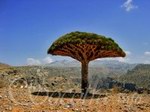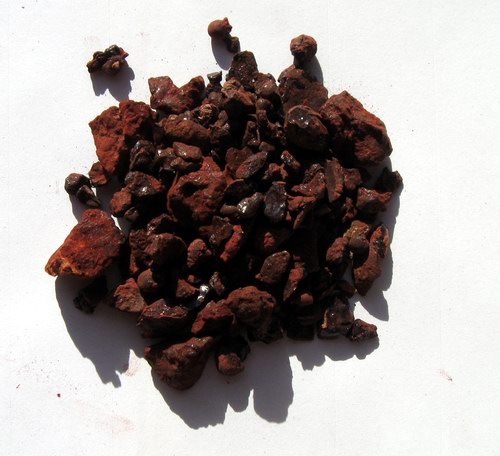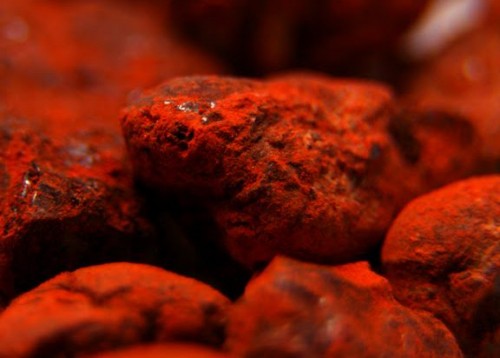
Dragon's blood is a bright red resin that is obtained from different species of a number of distinct plant genera: Croton, Dracaena, Daemonorops, Calamus rotang and Pterocarpus. The red resin was used in ancient times as varnish, medicine, incense, and dye. It continues to be employed for the aforementioned purposes by some.
Resin of Dracaena cinnabari from Socotra island:

Name and source
A great degree of confusion existed for the ancients in regard to the source and identity of dragon's blood. The resin of Dracaena species, "true" dragon's blood, and the very poisonous mineral cinnabar (mercury sulfide) were often confused by the ancient Romans, and there appears to have been a tendency to call anything that was bright red "dragon's blood". In ancient China, little or no distinction was made among the types of dragon's blood from the different species. Both Dracaena and Daemonorops resins are still often marketed today as dragon's blood, with little or no distinction being made between the plant sources; however, the resin obtained from Daemonorops has become the most commonly sold type in modern times, often in the form of large balls of resin.
Voyagers to the Canary Islands in the 15th century obtained dragon's blood as dried garnet-red drops from Dracaena draco, a tree native to the Canary Islands and Morocco. The resin is exuded from its wounded trunk or branches. Dragon's blood is also obtained by the same method from Dracaena cinnabari, which is endemic to the island of Socotra. This resin was traded to ancient Europe via the Incense Road.
Dragon's blood resin is also produced from the rattan palms of the genus Daemonorops of the Indonesian islands and known there as jerang or djerang. It is gathered by breaking off the layer of red resin encasing the unripe fruit of the rattan. The collected resin is then rolled into solid balls before being sold.
The red latex of the Sangre de Grado tree (Croton lechleri), native to north-eastern South America, has wound-healing and antioxidant properties, and has been used for centuries by native people.

Uses
The dragon's blood known to the ancient Romans was mostly collected from D. cinnabari, and is mentioned in the 1st century Periplus (30: 10. 17) as one of the products of Socotra. Socotra had been an important trading centre since at least the time of the Ptolemies. Dragon's blood was used as a dye and medicine (respiratory & gastrointestinal problems) in the Mediterranean basin, and was held by early Greeks, Romans, and Arabs to have medicinal properties. Dioscorides and other early Greek writers described its medicinal uses.
Locals of on Socotra island use the Dracaena resin as a sort of cure-all, using it for such things as general wound healing, a coagulant (though this is ill-advised with commercial products, as the Daemonorops species acts as an anti-coagulant and it is usually unknown what species the dragon's blood came from), curing diarrhea, lowering fevers, dysentery diseases, taken internally for ulcers in the mouth, throat, intestines and stomach, as well as an antiviral for respiratory viruses, stomach viruses and for such skin disorders as eczema. It was also used in medieval ritual magic and alchemy.
Dragon's blood of both Dracaena draco (commonly referred to as the Draconis Palm) and Dracaena cinnabari were used as a source of varnish for 18th century Italian violinmakers. There was also an 18th century recipe for toothpaste that contained dragon's blood. In modern times it is still used as a varnish for violins, in photoengraving, as an incense resin, and as a body oil.
Dragon's blood from both Daemonorops were used for ceremonies in India. Sometimes Dracaena resin, but more often Daemonorops resin, was used in China as red varnish for wooden furniture. It was also used to colour the surface of writing paper for banners and posters, used especially for weddings and for Chinese New Year.
In American Hoodoo, African-American folk magic, and New Orleans voodoo, it is used in mojo hands for money-drawing or love-drawing, and is used as incense to cleanse a space of negative entities or influences. It is also added to red ink to make "Dragon's Blood Ink", which is used to inscribe magical seals and talismans.
In folk medicine, dragon's blood is used externally as a wash to promote healing of wounds and to stop bleeding. It is used internally for chest pains, post-partum bleeding, internal traumas and menstrual irregularities.
In neopagan Witchcraft, it is used to increase the potency of spells for protection, love, banishing and sexuality. In New Age shamanism it is used in ceremonies in a similar way as the neopagans use it.
Dragon's blood incense is also sold as "red rock opium" to unsuspecting would-be drug buyers. It actually contains no opiates, and has only slight psychoactive effects, if any at all.
More information about the different types of dragon's blood
We offer original resin from a tree Dracaena cinnabari growing only on the island of Socotra. On market you can find a lot of fake resin.
Price per 100 gms*:
30-35$ crushed into small pieces or chank
25-30$ in crumb
20-25$ in powder (with trace of bark)
* Shipping is not included.
The price depends on the quality of the product and the possibilities of shipment from Socotra Island
Good discounts when buying resins for 1 or more kilograms
To order dragon`s blood send us a letter or contact us via WhatsApp
